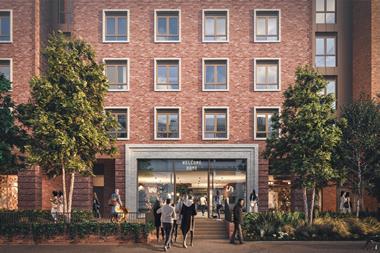The out-of-town market has had a turbulent year, with several big players falling by the wayside. But there is a new breed eager to fill the voids they have left, reports Ben Cooper
Out-of-town retail has not had the best of years. More than any other part of the retail market, it has taken the heat of the economic downturn and lost some of its most established players in the process. But retail is a resilient industry and some of the shrewdest brands are now seeing this as the opportunity that they have been waiting for.
Of the big-name retailers to have gone into administration in the past year, many are out-of-town players. But that doesn’t mean they won’t be replaced. In fact, even more than town centres, this market represents an opportunity for strong retailers keen to grow.
“If a retailer is serious about expansion, the retail warehouse market represents a good opportunity,” explains Cushman & Wakefield director of out-of-town Martin Supple. “There is an opportunity to get some big lumps of space relatively quickly.”
Retailers that have traditionally dominated out-of-town are having to face up to some serious truths. People are not moving home. White goods and furniture are tumbling down the sought-after list and, to top it all off, there is a wave of new competing retailers – and in particular, e-tailers – coming through and vying to capture consumers’ attentions.
The lack of credit and subsequent freeze in house moves have been devastating to the bulky goods and furnishing markets. A string of retailers including New Heights, Sleep Depot, Floors-2-Go, ScS and Beds Direct, to name a few, have fallen into administration. And speculation that other big names such as MFI are in difficulty refuses to go away.
But according to Savills head of research Mat Oakley, the turmoil in the housing market can have a silver lining as people invest in their existing homes rather than moving. “There’s an argument that the soft end of the DIY market actually does well when people aren’t moving house,” he says. “A lot of the big furniture retailers are not having a good time of it, but even if someone isn’t thinking about moving, if they’ve got a bit of disposable income they might still invest in some shelves or redecorate to refresh their present home.”
Because of the rate at which these and other retailers have fallen, landlords have been left with multiple voids that they are unable to fill. As a result, landlords are finding they have fewer bargaining chips when it comes to lease negotiations. They are having to be more flexible than even a year ago just to keep the tenants interested.
But while in some cases retailers vanish from existence, most are bought out from administration and emerge leaner and meaner. Retailers in administration dumping their weakest stores may present problems in the immediate short term, but it isn’t in the landlord’s interest to have poor performers that aren’t drawing in the customers and do nothing for the tenant mix on a park.
Thankfully for landlords, if not for retailers, rents are not yet falling, despite the market turmoil. However, the incentives they are having to make are still costly and, conversely, lucrative to retailers that can play their hands properly.
Incentives that were once considered desirable extras to a deal are becoming standard practice. Long rent-free periods, capped service charges and premiums to move onto a park have become the norm and nil-uplifts at rent-review are becoming more common. While the latter is harder to come by, B&Q has enjoyed a good run of 17 nil-uplift deals in the past 18 months.
DTZ head of retail warehouse agency Patrick Heaps says: “Tenants are looking very carefully at
costs and that is reflected in the proposals that are being made. But landlords are taking a longer-term view and waiting to get the tenant mix right and
some stability.”
But this does not mean there aren’t the odd rays of hope shining through. Retail resilience and the emergence of a new generation of out-of-town players means that there is still plenty of activity. And just because a retailer has gone into administration, it does not necessarily mean nightmare consequences
for a landlord. Readying themselves to take the voids that retailers release while in administration are retailers with in-town roots. Among the most notable of these are TK Maxx, Tesco Homeplus, Asda Living and, just recently, La Senza, which are all on the hunt for more stores. Also on the expansion march are established fashion retailers such as River Island, New Look, Matalan and Clarks.
“I think that the out-of-town market continues to provide an attractive proposition to the retail market,” says Heaps. “There are some retailers that only want out-of-town space. There is still a good cost comparison between out-of-town and in-town. We’re seeing acquisitions by retailers looking to expand and new entrants into the market.”
And this is the crux of the issue. Of course, not all retailers need or want warehouse-scale stores but, for those that do, the costs are much more viable relative to the equivalent space in-town. Hence the increasing trend of the more traditional in-town retailers such as River Island opening stores out-of-town. As Oakley explains: “Generally the story is similar to the high street. But a finance director can make a more persuasive argument to go into the out-of-town market because of the savings to be made on rent.
“More traditional, very large operators such as the DIY retailers have gradually been refining their outputs and, over the past six or seven years, we’ve seen an influx of general market retailers that are more used to the small stores in town going out of town.”
Not only is the type of retailers interested in out-of-town changing, but the requirements of those already there has also shifted subtly as a result.
A report published by Savills in May revealed a more careful approach among warehouse retailers than had previously been seen. The survey revealed that retailers were, even more than the year before, looking very carefully at their weakest stores with a view to closing shops. Of the 62 retailers surveyed, 24 per cent admitted that they planned to close between one and five out of town stores over the next 12 months, up from 20 per cent in the previous year.
The report cites the growth of the fashion retailer as a retail warehouse tenant as one of the causes of smaller average unit sizes being taken, which has been a growing trend for the past five years.
Perhaps most interestingly, however, was how effective the new arrivals have been at changing the face of the warehouse market. In 2003, 22 per cent of those surveyed by Savills said a DIY retailer was their ideal warehouse scheme anchor. This year, the anchor store of choice was a fashion retailer, chosen by 32 per cent of respondents. And when asked to name an individual retailer that they would choose to sit beside, the top three retailers were B&Q, Marks & Spencer and Next.
Matalan property director Jonathan Spaven says: “Fashion retailers drive footfall. Matalan has always been a preferred retailer to be with because we have driven footfall. Other fashion retailers are now seeing the benefits of being out of town because of the ease of accessibility, free parking and large buildings.”
Looking ahead, the most refreshing change in the market for both sides would be a few new players. The added competition this would bring would force retailers to up their game and give landlords the boost in demand they sorely need. “We need someone to add something to the out-of-town market,” says Supple. With Best Buy lining up a raft of new stores and French entertainment and electricals retailer Fnac gazing a hungry eye on the UK market, that boost might just be on the way.
The bottom line is that the woes in the retail warehouse market are, in fact, an opportunity for the right retailers. The number one priority for landlords now is to fill voids. Rents might not be falling, but landlords have been forced to bring more to the table to get new tenants to sign. With plenty of space to fill, it really is a tenant’s market.


























No comments yet